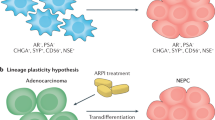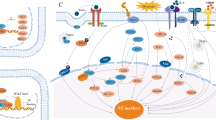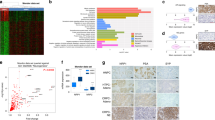Abstract
Neuroendocrine differentiation of the prostate is often associated with a dismal prognosis. Whilst it is relatively rare compared with other forms of prostate cancer, it nevertheless remains difficult to treat these cancers effectively and to maintain a durable response. Research aimed at understanding the complexity of neuroendocrine differentiation of the prostate has been conducted for some time. The cells involved in this process secrete a variety of factors that can influence growth patterns and regulatory pathways. Many of these factors can be monitored serologically, but the relationship between the biology of the tumor and clinical response is often discordant. This review outlines the difficulties in treating this disease, both at the time of diagnosis and in the metastatic setting, and focuses on an area of research that remains challenging to both the researcher and clinician.
Key Points
-
Prostate-cancer cell lines can be induced to differentiate into neuroendocrine cells when deprived of androgens or in the presence of interleukin-6 or increased levels of cyclic adenosine monophosphate
-
Clinical characteristics suggestive of a neuroendocrine tumor of the prostate include progressive symptoms, a low serum PSA level relative to the tumor burden, a poor response to hormonal ablation and visceral metastases
-
Immunohistochemistry or electron microscopy of tumor tissue can be used to identify neuroendocrine differentiation in prostate cancer
-
Although there is no definite marker, a number of different markers can be used in the diagnosis and management of patients with neuroendocrine prostate cancer (e.g. chromogranin A)
-
Neuroendocrine cancers are difficult to treat and are most effectively managed by certain combinations of chemotherapeutic drugs, which can be used in association with hormonal therapies and radiation of the prostate
This is a preview of subscription content, access via your institution
Access options
Subscribe to this journal
Receive 12 print issues and online access
$209.00 per year
only $17.42 per issue
Buy this article
- Purchase on Springer Link
- Instant access to full article PDF
Prices may be subject to local taxes which are calculated during checkout
Similar content being viewed by others
References
Amato K et al. (1992) Chemotherapy for small cell carcinoma of prostatic origin. J Urol 147: 935–937
Tetu B et al. (1987) Small cell carcinoma of the prostate: part I-A clinicopathologic study of 20 cases. Cancer 59: 1803–1809
Oesterling JE et al. (1992) Small cell anaplastic carcinoma of the prostate: a clinical, pathological and immunohistochemical study of 27 patients. J Urol 147: 804–807
Howe MC et al. (2005) Neuroendocrine differentiation in non-small cell lung cancer and its relation to prognosis and therapy. Histopathology 46: 195–201
Azzopardi JG and Evans DJ (1971) Argentaffin cells in prostatic carcinoma: differentiation from lipofuscin and melanin in prostatic epithelium. J Pathol 104: 247–251
Pearse AG and Takor T (1979) Embryology of the diffuse neuroendocrine and its relationship to the common peptides. Fed Proc 38: 2288–2294
Schron DS et al. (1984) The histogenesis of small cell carcinoma of the prostate: an immunohistochemical study. Cancer 53: 2478–2480
Bostwick DG et al. (1994) Neuroendocrine differentiation in prostate intrapeithelial neoplasia and adenocarcinoma. Am J Surg Pathol 18: 1240–1246
Di Sant'Agnese PA (2001) Neuroendocrine differentiation in prostatic carcinoma: an update on recent developments. Ann Oncol 12 (Suppl): S135–S140
Di Sant'Agnese PA (2000) Divergent neuroendocrine differentiation in prostatic carcinoma. Sem Diagn Pathol 17: 149–161
Muzzonigro G and Galosi AB (2002) Biological selection criteria for radical prostatectomy. Ann NY Acad Sci 963: 204–212
Helpap B et al. (1999) Undifferentiated carcinoma of the prostate with small cell features: immunohistochemical subtyping and reflections on histogenesis. Virchows Arch 434: 385–391
Helpap B et al. (1999) Neuroendocrine differentiation in prostate carcinomas: histogenesis, biology, clinical relevance, and future therapeutic perspectives. Urol Int 62: 133–138
Bonkhoff H and Remberger K (1996) Differentiation pathways and histogenetic aspects of normal and abnormal prostatic growth: a stem cell model. Prostate 28: 98–106
Bonkhoff H (1998) Neuroendocrine cells in benign and malignant prostate tissue morphogenesis, proliferation, and androgen receptor status. Prostate 8 (Suppl): S18–S22
Wang Q et al. (2004) Inhibitory effect of IL-6–induced neuroendocrine cells on prostate cancer cell proliferation. Prostate 61: 253–259
Algaba F et al. (1995) Neuroendocrine cells in peripheral prostatic zone: age, prostatic intraepithelial neoplasia and latent cancer-related changes. Eur Urol 27: 329–333
Rubinstein JH et al. (1997) Small cell anaplastic carcinoma of the prostate: seven new cases, review of the literature, and discussion of a therapeutic strategy. Am J Clin Oncol 20: 376–380
Vashchenko N and Abrahamsson PA (2005) Neuroendocrine differentiation in prostate cancer: implications for new treatment modalities. Eur Urol 47: 147–155
Berruti A et al. (2005) Independent prognostic role of circulating chromogranin A in prostate cancer patients with hormone refractory disease. Endocr Relat Cancer 12: 109–117
Amorino GP and Parsons SJ (2004) Neuroendocrine cells in prostate cancer. Crit Rev Eukaryot Gene Expr 14: 287–300
Bostwick DG et al. (2002) Neuroendocrine expression in node positive prostate cancer: correlation with systemic progression and patient survival. J Urol 168: 1204–1211
Daneshmand S et al. (2005) Ethnic differences in neuroendocrine cell expression in normal prostatic tissue. Urology 65: 1008–1012
Tokunaga M et al. (2005) Association of neuroendocrine differentiation with neoadjuvant hormone therapy effects in prostate cancer. Oncol Rep 13: 1081–1087
Iwamura M et al. (1998) Receptors for BPH growth factors are located in some neuroendocrine cells. Prostate 8 (Suppl): S14–S17
Wu JT et al. (1998) Serum chromogranin A: early detection of hormonal resistance in prostate cancer patients. J Clin Lab Anal 12: 20–25
Cussenot O et al. (1996) Plasma neuroendocrine markers in patients with benign prostatic hyperplasia and prostatic carcinoma. J Urol 155: 1340–1343
Syversen U et al. (2004) Clinical significance of elevated serum chromogranin A levels. Scand J Gastroenterol 39: 969–973
Sciarra A et al. (2003) Neuroendocrine differentiation in human prostatic tissue: is it detectable and treatable. BJU Int 91: 438–445
Angelsen A et al. (1997) Use of neuroendocrine serum markers in the follow-up of patients with cancer of the prostate. Prostate 31: 110–117
Birtle AJ and Freeman A (2003) Neuroendocrine differentiation in prostate cancer: is it detectable and treatable? Br J Urol 92: 490–492
Cox ME et al. (1999) Acquisition of neuroendocrine characteristics by prostate tumor cells is reversible: implications for prostate cancer progression. Cancer Res 59: 3821–3830
Di Sant'Agnese AP (1995) Neuroendocrine differentiation in prostatic carcinoma. Cancer 75 (Suppl): S1850–S1859
Wynick D and Bloom SR (1991) Clinical review 23: the use of long-acting somatostatin analog octreotide in the treatment of gut neuroendocrine tumors. J Clin Endocrinol Metab 73: 1–3
Kadar T et al. (1988) Receptors of prolactin, somatostatin, and luteinizing hormone-releasing in experimental prostate cancer after treatment with analogs of luteinizing hormone-releasing and somatostatin. Proc Natl Acad Sci USA 85: 890–894
Venkatesh PJ et al. (2004) Metastatic pure small-cell carcinoma of prostate. Am J Med Sci 328: 286–289
Papandreou CB et al. (2002) Results of phase II study with doxorubicin, etoposide and cisplatin in patients with fully characterized small-cell carcinoma of the prostate. J Clin Oncol 20: 3072–3080
Kelly WK et al. (1993) Prostate-specific antigen as a measure of disease outcome in metastatic hormone-refractory prostate cancer. J Clin Oncol 11: 607–615
Bonkhoff H and Fixemer T (2004) Neuroendocrine differentiation in prostate cancer. An unrecognized and therapy-resistant phenotype [German]. Urologe A 43: 836–842
Moore SR et al. (1992) Small cell carcinoma of the prostate: effectiveness of hormonal versus chemotherapy. Urology 39: 411–416
Sundin A et al. (2004) PET in the diagnosis of neuroendocrine tumors. Ann NY Acad Sci 1014: 246–257
Schwartz LH et al. (1998) Small cell and anaplastic prostate cancer: correlation between CT findings and prostate-specific antigen level. Radiology 208: 735–738
Matsumori N et al. (2004) An allograft model of androgen independent prostatic neuroendocrine carcinoma derived from a large probasin promoter-T antigen transgenic mouse line. J Urol 171: 439–442
True L (2004) Why we must better understand neuroendocrine differentiation in prostate cancer. J Urol 171: 443–444
Author information
Authors and Affiliations
Corresponding author
Ethics declarations
Competing interests
The author declares no competing financial interests.
Rights and permissions
About this article
Cite this article
Slovin, S. Neuroendocrine differentiation in prostate cancer: a sheep in wolf's clothing?. Nat Rev Urol 3, 138–144 (2006). https://doi.org/10.1038/ncpuro0435
Received:
Accepted:
Issue Date:
DOI: https://doi.org/10.1038/ncpuro0435
This article is cited by
-
Neuroendocrine differentiation of prostate cancer
Asian Journal of Andrology (2013)
-
FDG PET-CT demonstration of metastatic neuroendocrine tumor of prostate
World Journal of Surgical Oncology (2008)
-
Does small-cell phenotype predict the natural history of prostate cancer? A case study in disease behavior
Nature Clinical Practice Oncology (2007)
-
The grey zone between pure (neuro)endocrine and non-(neuro)endocrine tumours: a comment on concepts and classification of mixed exocrine–endocrine neoplasms
Virchows Archiv (2006)



